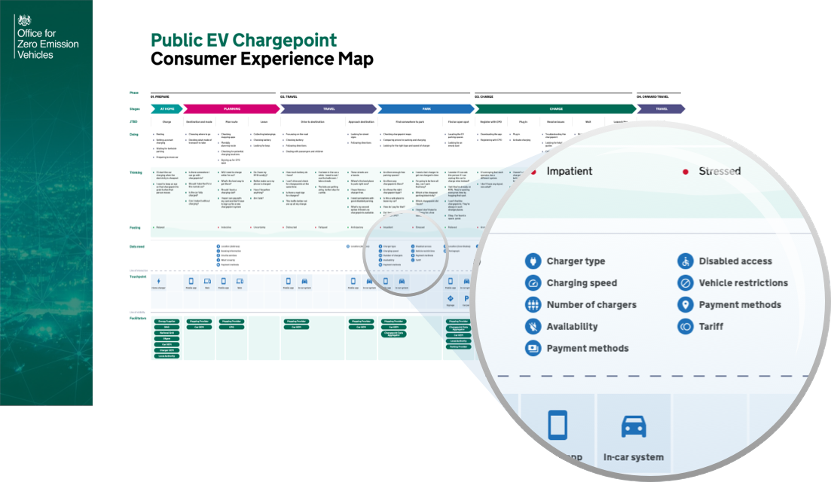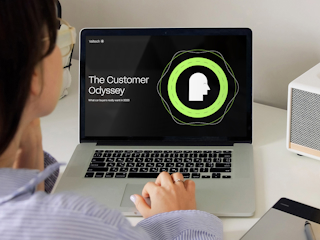OZEV’s focus is to get more people to use zero-emission vehicles. But how do we achieve that? Having consulted across stakeholder groups, one consistent theme was that the availability of data is critical to improving the user experience of chargepoints and that this will lead to more people adopting EVs.
Specifically, EV drivers have “range anxiety” about where and when they can next charge their vehicle. To be confident about making the switch, they need reliable and consistent information about where they can find a useable chargepoint.
User anxiety is higher when individuals have mobility issues. These can include problems with the weight of charging cables or parking arrangements unsuitable for wheelchair users. Recent research estimates there will be 2.7 million disabled drivers or passengers by 2035, with 1.35 million expected to be partially or wholly reliant on public charging infrastructure3.
Meanwhile, local authorities and the energy suppliers who provide chargepoints need data to help ensure that new chargepoints are located where it’s feasible to put them and where they’re needed. The richness of data isn’t currently available that can enable sensible chargepoint planning for users or operators, plus there are business opportunities to fill these gaps.
OZEV decided to conduct a Discovery on open data and where it can contribute to their goals to learn more4. Specifically, OZEV wanted the Discovery to:
-
Fully understand consumer and industry needs
-
Identify whether existing approaches in the transport, energy and other utility sectors could meet those needs
-
Confirm the feasibility and application of data standards to support the outcomes
-
Suggest viable, future-proofed, practical solutions for how data can be made available and used to meet all the needs of consumers
How we Approach the Discovery
When Valtech bid for this work, we put together a unique package. As well as building on our proven track record of conducting successful Discoveries and our established reputation for creating good government services, we also partnered with TRL to ensure we had appropriate, detailed domain knowledge.
TRL was originally the UK Government’s road research body and is now an independent team of expert scientists and engineers working with clients on the future of transport. They’d recently conducted European-wide consumer research on EVs. Our proposition to OZEV was that our team had the skills to complete an effective data discovery project, and the domain knowledge to hit the ground running and make the best use of the time available.
Discoveries are highly focused and time limited. To organise our time effectively, we divided our plan into four stages. The first was identifying all the existing knowledge in the current landscape, filling in the gaps with our own research. The second was processing all the raw information we’d gathered to extract insights and create propositions.
In the third stage, we recombined the propositions and generated ideas about how each could be tackled or solved. We also grouped, consolidated and refined the propositions to identify the most achievable and the ones that would have the biggest impact on the customer experience or on mitigating risk. The final phase involved making recommendations on what the next steps could be and proposals on how to take them forward.
Outputs from the Discovery
By the conclusion of the Discovery, we’d mapped user needs to a comprehensive experience map (a storyboard with layers) and analysed data models to assess their fitness for purpose. In addition, we’d developed an understanding of how other countries/bodies are achieving the same open data objective and had produced a clear set of recommendations for the alpha phase, including at least one tangible solution.

We concluded that the lack of standardisation in public charging means that people can’t easily access the chargepoint information they need. It significantly degrades the charging experience and, by extension, reduces the potential for EV ownership. We also concluded that the best customer experience for chargepoints is a ‘forgettable’ one. Consumers want to get from A to B, thinking about the destination, not the journey. Few motorists worry about the location of petrol stations when planning a trip. If the chargepoint experience can become similar, it’s been a success.
Importantly, we realised that much of the existing research on EV use is skewed. It’s based on current EV owners, who represent approximately 2.5 per cent of drivers. These are ‘innovators’ who tend to be very forgiving of the current challenges of EV ownership. They’re atypical and don’t safely predict the attitude and behaviours of the ‘mainstream’ population that we need to embrace EVs. Our research therefore considered both current and potential future EV owners.
We also concluded that just a small amount of relatively simple “static” data would make a big difference to the customer experience. It appears that even though most EVs have significantly more capacity than is required for most journeys, range anxiety persists. This is tied to a perceived scarcity of chargers, which would be improved by a) more chargers and b) more visibility of the charging network (through open data).
Open data would also indirectly improve the customer experience by, for example, helping improve city planning. And it would help customers with access needs, who sometimes need to drive to multiple chargers to find a usable one.
We also learned that charging and parking are inextricably linked, causing the behaviour patterns between the two to be muddled. Finally, we found that in Europe there’s a significant correlation between mandating or funding data sharing and reporting of chargepoint data and widespread EV adoption.







